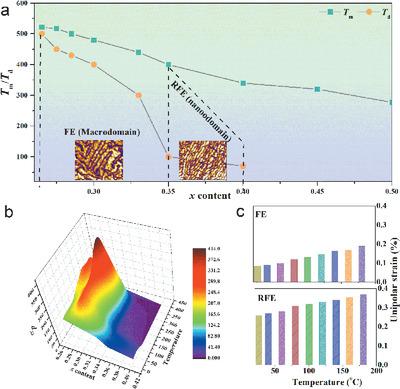当前位置:
X-MOL 学术
›
Adv. Electron. Mater.
›
论文详情
Our official English website, www.x-mol.net, welcomes your
feedback! (Note: you will need to create a separate account there.)
Perovskite BiFeO3–BaTiO3 Ferroelectrics: Engineering Properties by Domain Evolution and Thermal Depolarization Modification
Advanced Electronic Materials ( IF 5.3 ) Pub Date : 2020-03-20 , DOI: 10.1002/aelm.202000079 Ting Zheng 1 , Jiagang Wu 1
Advanced Electronic Materials ( IF 5.3 ) Pub Date : 2020-03-20 , DOI: 10.1002/aelm.202000079 Ting Zheng 1 , Jiagang Wu 1
Affiliation

|
Bismuth ferrite (BFO)‐based ceramics with large electromechanical response are important in electronic device applications. To better understand their physical mechanisms, a new phase diagram established by temperature dependence of dielectric properties, temperature dependence of piezoelectric coefficient, and the evolution of their properties is proposed to explain the contribution of piezoelectric and strain response by comparing ferroelectric (FE) and relaxor ferroelectric (RFE) compositions. The FE components with macrodomains have large piezoelectric constant (d33 of 412 pC/N) at high temperature. The RFE components with nanodomains possess giant strain response (Suni = 0.37%) at 180 °C. Combined with in situ and ex situ techniques, the physical mechanisms behind the enhancement of these properties are explored. Macrodomains and multipolar phase coexistence contribute to the piezoelectricity improvement. Nanodomains and an unstable depolarization temperature (Td) region engineer the strain enhancement, which can promote electric‐field‐induced domain switching, lattice strain, and irreversible phase transition. In particular, the Td region of BiFeO3‐based ceramics has been ignored for several years, although it is actually an effective medium to engineer properties. The proposed phase diagram and dynamic model can be used to well understand the structural origins of large electromechanical properties in BFO‐based ceramics, which can give some guidance to explore materials with excellent properties for different applications.
中文翻译:

钙钛矿BiFeO3-BaTiO3铁电体:通过畴演化和热去极化修饰的工程特性
具有大机电响应的基于铁酸铋(BFO)的陶瓷在电子设备应用中很重要。为了更好地了解它们的物理机制,提出了一种由介电特性的温度依赖性,压电系数的温度依赖性以及它们的性能演化建立的新相图,以通过比较铁电体(FE)和弛豫器来解释压电和应变响应的贡献。铁电(RFE)组合物。具有大畴的FE组分在高温下具有较大的压电常数(d 33为412 pC / N)。具有纳米域的RFE组件具有巨大的应变响应(S uni= 0.37%)在180°C下。结合原位和异位技术,探索了增强这些特性的物理机制。大畴和多极相共存有助于压电性的提高。纳米域和不稳定的去极化温度(T d)区域可改善应变,从而促进电场诱导的域切换,晶格应变和不可逆相变。特别是BiFeO 3的T d区尽管基于陶瓷的陶瓷实际上是设计特性的有效媒介,但多年来一直被忽略。所提出的相图和动力学模型可以用来很好地理解BFO基陶瓷的大机电性能的结构起源,从而可以为探索具有不同应用的优异性能的材料提供一些指导。
更新日期:2020-03-20
中文翻译:

钙钛矿BiFeO3-BaTiO3铁电体:通过畴演化和热去极化修饰的工程特性
具有大机电响应的基于铁酸铋(BFO)的陶瓷在电子设备应用中很重要。为了更好地了解它们的物理机制,提出了一种由介电特性的温度依赖性,压电系数的温度依赖性以及它们的性能演化建立的新相图,以通过比较铁电体(FE)和弛豫器来解释压电和应变响应的贡献。铁电(RFE)组合物。具有大畴的FE组分在高温下具有较大的压电常数(d 33为412 pC / N)。具有纳米域的RFE组件具有巨大的应变响应(S uni= 0.37%)在180°C下。结合原位和异位技术,探索了增强这些特性的物理机制。大畴和多极相共存有助于压电性的提高。纳米域和不稳定的去极化温度(T d)区域可改善应变,从而促进电场诱导的域切换,晶格应变和不可逆相变。特别是BiFeO 3的T d区尽管基于陶瓷的陶瓷实际上是设计特性的有效媒介,但多年来一直被忽略。所提出的相图和动力学模型可以用来很好地理解BFO基陶瓷的大机电性能的结构起源,从而可以为探索具有不同应用的优异性能的材料提供一些指导。











































 京公网安备 11010802027423号
京公网安备 11010802027423号